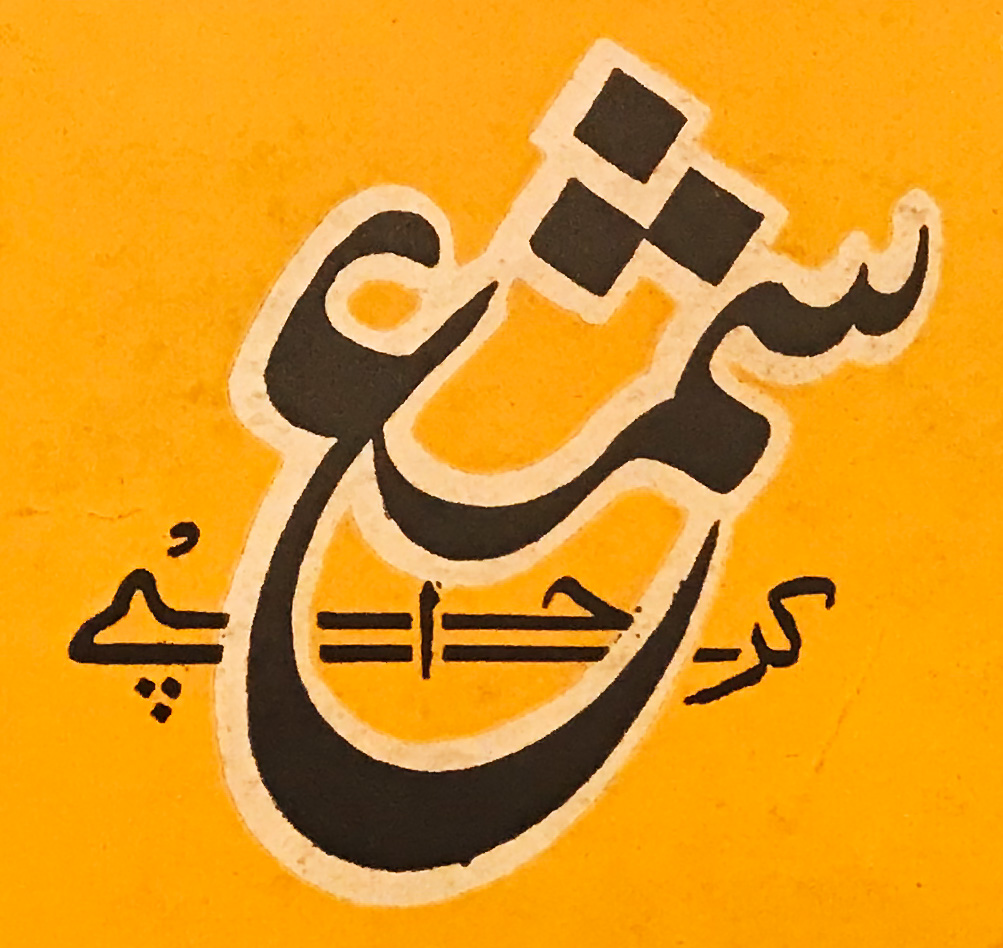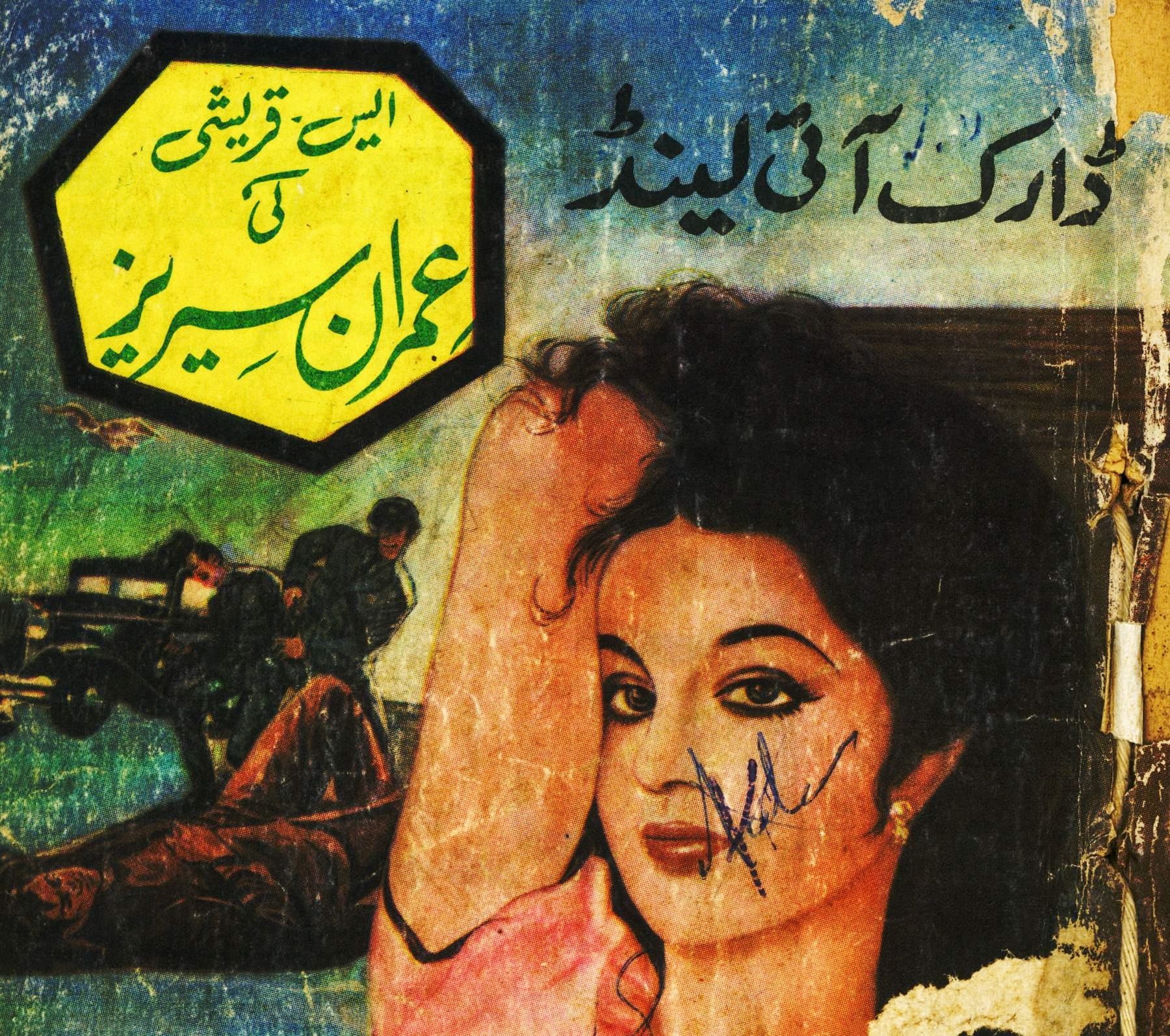13. Special marks and unusual spellings
You have now learned the entire Urdu alphabet, as well as the numerals and other important marks and symbols. In this chapter, we introduce some of the less common symbols, as well as some archaic and unusual spellings and other niceties. This chapter is primarily meant for specialist readers who are interested in accessing literary or historical texts.
Poetic marks
Urdu possesses a range of special marks and abbreviations. A particularly common mark is the small scooped line written over a taḳhallus or pen name:
Mīnā Kumārī ‘Nāz’
Occasionally, other proper nouns are indicated with this mark, or with a straight line drawn above them.
Poetic couplets are indicated with ؎ or ؔ . Individual lines of poetry are marked with either a plain or ornamental ain: ؏ / ع (derived from the last letter of the word for a hemistich or half-verse, مصرع misra).
Islamic marks
Urdu uses a range of Islamic honorific phrases taken from Arabic that are invoked after the names of revered individuals. Several of these phrases can be indicated through short abbreviations above the names of the individuals they refer to (alternatively, they can be written out in full).
Several such phrases and their special markings or characters are commonly used. The first is a small initial swād written over the name of the Prophet Muhammad. This is short for the phrase “sallallāhu alaihi wa sallam,” or, “may God honor him and grant him peace.” This full phrase also appears in computerized texts in a compact form. In addition to prompting the reader to recite the phrase after the name, these markings also help indicate when an epithet for the Prophet is being used:
محمدؐ
Muhammad(saw)
آنحضرتؐ
Ānhazrat(saw)
رسول ﷲﷺ
Rasūl Allāh(saw)
Another common symbol is ؓ . This marking, which contains a superscript re and an initial zwād, is short for the pious phrase “razī Allāh anhu” (or any alternative ending, including: anha / anhuma / anhum / anhunna). The phrase means “may God be pleased with them.” This honorific phrase is typically applied to companions of the Prophet:
خدیجہؓ
Ḳhadīja(ra)
حضرت عمرؓ
Hazrat Umar(ra)
A pious phrase used after the names of saints and revered individuals is “rahmat Allāh alaih” (and alaiha, alaihum, etc.), meaning “God’s Mercy upon them.” This is represented by ؒ , a superscript re and initial (or sometimes independent) baṛī he:
حضرت نظام الدین اولیاؒ
Hazrat Nizām ud-Dīn Auliyā(rh) (a Sufi saint)
Unusual and archaic letters and spellings
Conventions for writing Urdu developed slowly over time. Before the nineteenth century, Urdu was often written using only the characters and conventions available in Persian. Over time, though, new letters and conventions were developed to more accurately represent the spoken language, and modern spelling was standardized by the early twentieth century. For instance, there was initially no unique character used to write the sound ṭ; ت was used where we would now use ٹ. Later versions included those featuring four dots, or two dots and a small to’e: ٿ and ؕت. Similar letters were used for ḍ and ṛ.
Nūn-e ġhunna is also a relatively new addition to the alphabet. Older books simply used the ordinary nūn for both the n and ñ sounds.
Similarly, older texts sometimes use kāf for gāf, and also sometimes omit the hamza separating a vowel from ye, e.g. براے instead of برائے.
Some variant spellings continue to be used from time to time. Occasionally, an inverted pesh (ulṭā pesh) is written over a wāw to indicate an ū pronunciation: وٗ. A few letters have alternate forms that are more typical of Persian or Arabic. Chhoṭī ye is sometimes written with two dots in the final and independent forms, as in Arabic. Similarly, kāf sometimes appears as ک or ﻙ. A special form of chhoṭī he with two dots above (called te marbūta) sometimes appears at the end of words, and is pronounced as a t, as in رحمۃ rahmat ‘mercy’ (normally most such words are spelled with an ordinary te).
Some letters that are now typically distinct were historically used interchangeably. These include chhoṭī he and do-chashmī he, and chhoṭī and baṛī ye. Occasionally, some of these will appear even in modern times, either for aesthetic or practical reasons. The name Ali, for instance, is properly written علی but is frequently seen in a more stylized version as علے. In the image below, the film magazine Shama uses a baṛī ye to add some visual flair to its place of publication, Karāchī ‘Karachi’:
 Image source: David Boyk.
Image source: David Boyk.
We’ve previously mentioned the elongated kashīda letters that are used both to add beauty and to fill up space on a line. Sometimes calligraphers, who wrote out nearly every Urdu book published before the early twenty-first century, also need to condense a line of text to squeeze it into the available space, or simply to make it look attractive. One way to do this is with a more compact form of baṛī ye, which looks like a truncated chhoṭī ye: ؠ. Another is to pile up letters vertically, as in this advertisement for a hair product:
 Image source: David Boyk.
Image source: David Boyk.Although moveable type never became popular in Urdu, it was used occasionally. Texts typeset in metal tend to be in a somewhat disjointed Naskh:
 Panḍit Lachhmī Dhar Shāstrī Mishan Kālij Děhlī (Pandit Lachhmi Dhar Shastri, Mission College, Delhi). Image source: Rekhta.
Panḍit Lachhmī Dhar Shāstrī Mishan Kālij Děhlī (Pandit Lachhmi Dhar Shastri, Mission College, Delhi). Image source: Rekhta.Word spacing has also changed somewhat over time. Some texts, especially older ones, will often use اسکا instead of اس کا, اسلئے for اس لئے, صورتحال for صورتِ حال, and so forth. There is also plenty of inconsistency in whether or not to write prefixes and suffixes as separate words, e.g. بے وقوف / بیوقوف be-vaqūf ‘fool,’ جائے گا / جائیگا jā’egā ‘will go,’ رام پور / رامپور Rāmpūr ‘Rampur,’ etc. Similarly, English words are sometimes broken into two, as on the cover of this mystery novel:
 S. Qureshī, Ḍārk Ā’īlainḍ (Dark Island). Image source: University of Texas at Austin.
S. Qureshī, Ḍārk Ā’īlainḍ (Dark Island). Image source: University of Texas at Austin.Practice
This passage includes many of the features discussed in this chapter. Explore the image to learn more.
Karīm Alī Raṭhī, Bāġh-e Nau Bahār. Image source: Daniel Majchrowicz.
In a small number of Arabic words, an alif-madd appears in the middle of a word. It is pronounced as ā and begins a new syllable:
قرآن
qur’ān ‘Quran’
مرآت
mir’āt ‘mirror’
Practice
How many of the special features covered in this chapter and Chapters 10 and 11 can you find on this title page of a famous nineteenth-century novel?
Nazīr Ahmad, Mir’āt ul-Urūs (The Bride’s Mirror), published by Kutub-Ḳhāna-e Ilm o Adab, Děhlī (‘The Knowledge and Literature Bookshop, Delhi’). Image source: Rekhta (edited).
Words ending in chhoṭī he sometimes follow special spelling rules when they are declined or made into the plural. Of course, regular masculine nouns, i.e. those ending in –a or –ā, acquire an –e ending when they are either plural or oblique. When such a word ends with a chhoṭī he rather than an alif, its spelling either may or may not reflect that pronunciation:
کتب خانہ میں
kutub-ḳhāne meñ ‘in the library’
ذمہ داری
zimmedārī ‘responsibility’
اس موقعہ پر
is mauqe par ‘on this occasion’
Place names can be both pronounced and written with either an -e or an -a ending:
|
آگرے سے Āgre se ‘from Agra’ |
آگرہ سے Āgre se ‘from Agra’ |
آگرہ سے Āgra se ‘from Agra’ |
For more details on reading historical texts, see Brian Spooner and William L. Hanaway’s manual, Reading Nasta‘liq: Persian and Urdu Hands from 1500 to the Present.
کشیدہ
A way of writing elongated letters, traditionally used for justifying lines of text (rather than by adjusting white space, as is typical in English) and for ornamental purposes. Literally “pulled.”
Hindi-Urdu words or phrases that are followed by a postposition are in the oblique case: bachcha becomes bachche ko, kitābeñ becomes kitāboñ meñ, and so forth.
